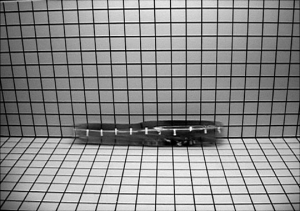
source: Hong/Ingram
Discovery.com is reporting today that researchers from the Virginia Polytechnic Institute and State University have developed a robot that does not use wheels or legs to move, but rather uses its skin as its means of propulsion in much the same way that amoeba do. While this method of locomotion will not be practical in most applications it does give the robot the unique ability of squeezing through spaces that are much smaller than its own diameter – a feat not easily accomplished by robots employing traditional propulsion systems.
The robot was developed by engineering professor Dennis Hong and his graduate student Mark Ingram. Hong is already well known for his outside-of-the-box thinking in regards to robot locomotion. Just last week we reported on his efforts to build a robot with “whegs,” a combination of wheels and legs. Hong and Ingram’s “whole-skin locomotion,” while inspired by amoeba, does not replicate the physical process exactly. They have, however, built a system that uses the same principles and produces the same type of motion.
Amoeba is a genus of well-known unicellular organisms consisting of a liquid endoplasm surrounded by an amorphous, gel-like ectoplasm. In order to move, the endoplasm flows to the front of the organism where it breaks through the ectoplasm skin and is converted into ectoplasm itself. Concurrently, the ectoplasm skin at the rear of the amoeba liquefies into endoplasm. Theses changes in its skin drive the amoeba forward.
In order to replicate this motion, Hong and Ingram’s robot is built like a hollow sausage. The exoskeleton consists of several rings covered by a flexible membrane. When the rings contract or expand, the skin slides forward (or backward) causing the robot to move. This allows the robot to turn itself completely inside out in one smooth motion. This description of the structure and appearance immediately reminded me of the water snake toys that were popular in the 1980s, although they had no skeletal structure.
This design makes the robot uniquely suitable for applications including squeezing between obstacles and fitting through openings smaller in diameter than itself. The major drawback at this time is the durability of its skin since it is in constant contact with the terrain. The researchers are evaluating using a wire mesh instead in order to address that problem.
